Characterization of Luminescent Down-Shifting Spectral Conversion Effects on Silicon Solar Cells with Various Combinations of Eu-Doped Phosphors
Abstract
:1. Introduction
2. Material and Methods
2.1. Characterization of SiO2 LDS Layers Containing Phosphors
2.1.1. Single Coating with Single Phosphor Particles
2.1.2. Double-Coatings Using Two Types of Phosphor Particles
2.2. Characterization of Solar Cells with a Single Layer or Dual Layers of SiO2 Containing Phosphors
3. Results and Discussion
3.1. Characteristics of LDS Layers Containing Phosphors
3.2. Performance of Silicon Solar Cells Coated with LDS Layers Comprising One or Two Phosphors
4. Conclusions
Author Contributions
Funding
Institutional Review Board Statement
Informed Consent Statement
Data Availability Statement
Conflicts of Interest
References
- Tryyestad, C.; Sharma, N.; Rolser, O.; Smeets, B.; van de Staaij, J.; Gruenewald, T. Global Energy Perspective 2021: Reference case, Energy Insights by McKinsey & Company. January 2021. Available online: https://www.mckinsey.com/industries/oil-and-gas/our-insights/global-energy-perspective-2021 (accessed on 1 January 2021).
- Kober, T.; Schiffer, H.-W.; Densing, M.; Panos, E. Global energy perspectives to 2060—WEC’s world energy scenarios 2019. Energy Strateg. Rev. 2020, 31, 100523. [Google Scholar] [CrossRef]
- IRENA. Global Renewables Outlook: Energy Transformation 2050; International Renewable Energy Agency: Abu Dhabi, United Arab Emirates, 2020. [Google Scholar]
- IRENA. Future of Solar Photovoltaic: Deployment, Investment, Technology, Grid Integration and Socio-Economic, Aspects (A Global Energy Transformation: Paper); International Renewable Energy Agency: Abu Dhabi, United Arab Emirates, 2019; Available online: https://irena.org/-/media/Files/IRENA/Agency/Publication/2019/Nov/IRENA_Future_of_Solar_PV_2019.pdf (accessed on 1 November 2019).
- Gielen, D.; Boshell, F.; Saygin, D.; Bazilian, M.D.; Wagner, N.; Gorini, R. The role of renewable energy in the global energy transformation. Energy Strateg. Rev. 2019, 24, 38–50. [Google Scholar] [CrossRef]
- Hirst, L.C. 1.14 Principles of Solar Energy Conversion. Compr. Renew. Energy 2012, 1, 293–313. [Google Scholar] [CrossRef]
- Battaglia, C.; Cuevas, A.; Wolf, S.D. High-efficiency crystalline silicon solar cells: Status and perspectives. Energy Environ. Sci. 2016, 9, 1552–1576. [Google Scholar] [CrossRef] [Green Version]
- Roosloot, N.; Neder, V.; Haug, H.; You, C.C.; Polman, A.; Marstein, E.S. Broadband angular color stability of dielectric thin film-coated pyramidal textured Si for photovoltaics. J. Appl. Phys. 2021, 129, 173104. [Google Scholar] [CrossRef]
- Kale, A.S.; Nemeth, W.; Guthrey, H.; Page, M.; Al-Jassim, M.; Young, D.L.; Agarwal, S.; Stradins, P. Modifications of textured silicon surface morphology and its effect on poly-Si/SiOx contact passivation for silicon solar cells. IEEE J. Photovolt. 2019, 9, 1513–1521. [Google Scholar] [CrossRef]
- Shanmugam, N.; Pugazhendhi, R.; Elavarasan, R.M.; Kasiviswanathan, P.; Das, N. Anti-reflective coating materials: A holistic review from PV perspective. Energies 2020, 13, 2631. [Google Scholar] [CrossRef]
- Sagar, R.; Rao, A. Nanoscale TiO2 and Ta2O5 as efficient antireflection coatings on commercial monocrystalline silicon solar cell. J. Alloys Compd. 2021, 862, 158464. [Google Scholar] [CrossRef]
- Meyer, F.; Savoy, A.; Leon, J.J.D.; Persoz, M.; Niquille, X.; Allebé, C.; Nicolay, S.; Haug, F.-J.; Ingenito, A.; Ballif, C. Optimization of front SiNx/ITO stacks for high-efficiency two-side contacted c-Si solar cells with co-annealed front and rear passivating contacts. Sol. Energy Mater. Sol. Cells 2021, 219, 110815. [Google Scholar] [CrossRef]
- Hirst, L.C.; Ekins-Daukes, N.J. Fundamental losses in solar cells. Prog. Photovolt Res. Appl. 2011, 19, 286–293. [Google Scholar] [CrossRef]
- Tiedje, T.; Yablonovitch, E.; Cody, G.D.; Brooks, B.G. Limiting efficiency of silicon solar cells. IEEE Trans. Electron. Devices 1984, ED-31, 711–716. [Google Scholar] [CrossRef]
- Richter, A.; Hermle, M.; Glunz, S.W. Reassessment of the limiting efficiency for crystalline silicon solar cells. IEEE J. Photovolt. 2013, 3, 1184–1191. [Google Scholar] [CrossRef]
- Klampaftis, E.; Richards, B.S. Improvement in multi-crystalline silicon solar cell efficiency via addition of luminescent material to EVA encapsulation layer. Prog. Photovolt. Res. Appl. 2011, 19, 345–351. [Google Scholar] [CrossRef]
- Chander, N.; Sardana, S.K.; Parashar, P.K.; Khan, A.F.; Chawla, S.; Komarala, V.K. Improving the short-wavelength spectral response of silicon solar cells by spray deposition of YVO4:Eu3+ downshifting phosphor nanoparticles. IEEE J. Photovolt. 2015, 5, 1373–1379. [Google Scholar] [CrossRef]
- Day, J.; Senthilarasu, S.; Mallick, T.K. Improving spectral modification for applications in solar cells: A review. Renew. Energy 2019, 132, 186–205. [Google Scholar] [CrossRef]
- Liu, S.-M.; Chen, W.; Wang, Z.-G. Luminescence Nanocrystals for Solar Cell Enhancement. J. Nanosci. Nanotechnol. 2010, 10, 1418–1429. [Google Scholar] [CrossRef] [PubMed]
- Romero-Romo, W.; Carmona-Téllez, S.; Lozada-Morales, R.; Soriano-Romero, O.; Caldiño, U.; Álvarez-Ramos, M.E.; Zayas, M.E.; Meza-Rocha, A.N. Down-shifting and down-conversion emission properties of novel CdO-P2O5 invert glasses activated with Pr3+ and Pr3+/Yb3+ for photonic applications. Opt. Mater. 2021, 116, 111009. [Google Scholar] [CrossRef]
- Chang, W.; Li, L.; Dou, M.; Yan, Y.; Jiang, S.; Pan, Y.; Cui, M.; Wu, Z.; Zhou, X. Dual-mode downconversion luminescence with broad near-ultraviolet and blue light excitation in Tm3+/Yb3+ codoped oxy-fluoride glasses for c-Si solar cells. Mater. Res. Bull. 2019, 112, 109–114. [Google Scholar] [CrossRef]
- Yadav, R.V.; Yadav, R.S.; Bahadur, A.; Rai, S.B. Down shifting and quantum cutting from Eu3+, Yb3+ co-doped Ca12Al14O33 phosphor: A dual mode emitting material. RSC Adv. 2016, 6, 9049–9056. [Google Scholar] [CrossRef]
- Jia, Y.; Poncé, S.; Miglio, A.; Mikami, M.; Gonze, X. Design rule for the emission linewidth of Eu2+-activated phosphors. J. Lumines. 2020, 224, 117258. [Google Scholar] [CrossRef]
- Shao, G.; Lou, C.; Xiao, D. Enhancing the efficiency of solar cells by down shifting YAG: Ce3+ phosphors. J. Lumines. 2015, 157, 344–348. [Google Scholar] [CrossRef]
- Klampaftis, E.; Ross, D.; McIntosh, K.R.; Richards, B.S. Enhancing the performance of solar cells via luminescent down-shifting of the incident spectrum: A review. Sol. Energy Mater. Sol. Cells 2009, 93, 1182–1194. [Google Scholar] [CrossRef]
- AL-Shomar, S.M. Synthesis and characterization of Eu3+ doped TiO2 thin films deposited by spray pyrolysis technique for photocatalytic application. Sol. Energy Mater. Res. Express 2021, 8, 026402. [Google Scholar] [CrossRef]
- Yang, X.; Chen, J.; Zheng, S.; Chen, C. A downshifting Eu3+ doped glass embedded with concave pyramid microstructure to improve the efficiency of silicon solar cell. J. Rare Earths 2020, 38, 1158–1164. [Google Scholar] [CrossRef]
- Fix, T.; Nonat, A.; Imbert, D.; Pietro, S.D.; Mazzanti, M.; Slaoui, A.; Charbonnière, L.J. Enhancement of silicon solar cells by downshifting with Eu and Tb coordination complexes. Prog. Photovolt. Res. Appl. 2016, 24, 1251–1260. [Google Scholar] [CrossRef]
- Ho, W.-J.; Shen, Y.-T.; Liu, J.-J.; You, B.-J.; Ho, C.-H. Enhancing photovoltaic performance using broadband luminescent down-shifting by combining multiple species of Eu-doped silicate phosphors. Nanomaterials 2017, 7, 340. [Google Scholar] [CrossRef] [PubMed]
- Benharrat, L.; Guerbous, L.; Bradai, D.; Boukerika, A.; Manseri, A.; Selmi, N.; Rahal, B.; Hamroun, M.S.E. Preparation and characterization of luminescent YPO4: Eu3+ thin films using sol gel spin coating method. Thin Solid Film. 2020, 694, 137738. [Google Scholar] [CrossRef]
- Ho, W.-J.; Shen, Y.-T.; Deng, Y.-J.; Yeh, C.-W.; Sue, R.-S. Performance enhancement of planar silicon solar cells through utilization of two luminescent down-shifting Eu-doped phosphor species. Thin Solid Film. 2016, 618, 141–145. [Google Scholar] [CrossRef]
- Ho, W.-J.; You, B.-J.; Liu, J.-J.; Bai, W.-B.; Syu, H.-J.; Lin, C.-F. Photovoltaic performance enhancement of silicon solar cells based on combined ratios of three species of europium-doped phosphors. Materials 2018, 11, 845. [Google Scholar] [CrossRef] [PubMed] [Green Version]
- Lu, P.-C.; Ho, W.-J.; Liu, J.-J.; Yu-Ren Chen, Y.-R.; Chien, Y.-C.; Chiu, W.-C. External quantum efficiency response and conversion efficiency enhancement of silicon solar cells based on multiple layers of up conversion phosphors coating. In Proceedings of the Opto-Electronics and Communications Conference (OECC) 2020, Taipei, Taiwan, 4–8 October 2020. [Google Scholar] [CrossRef]

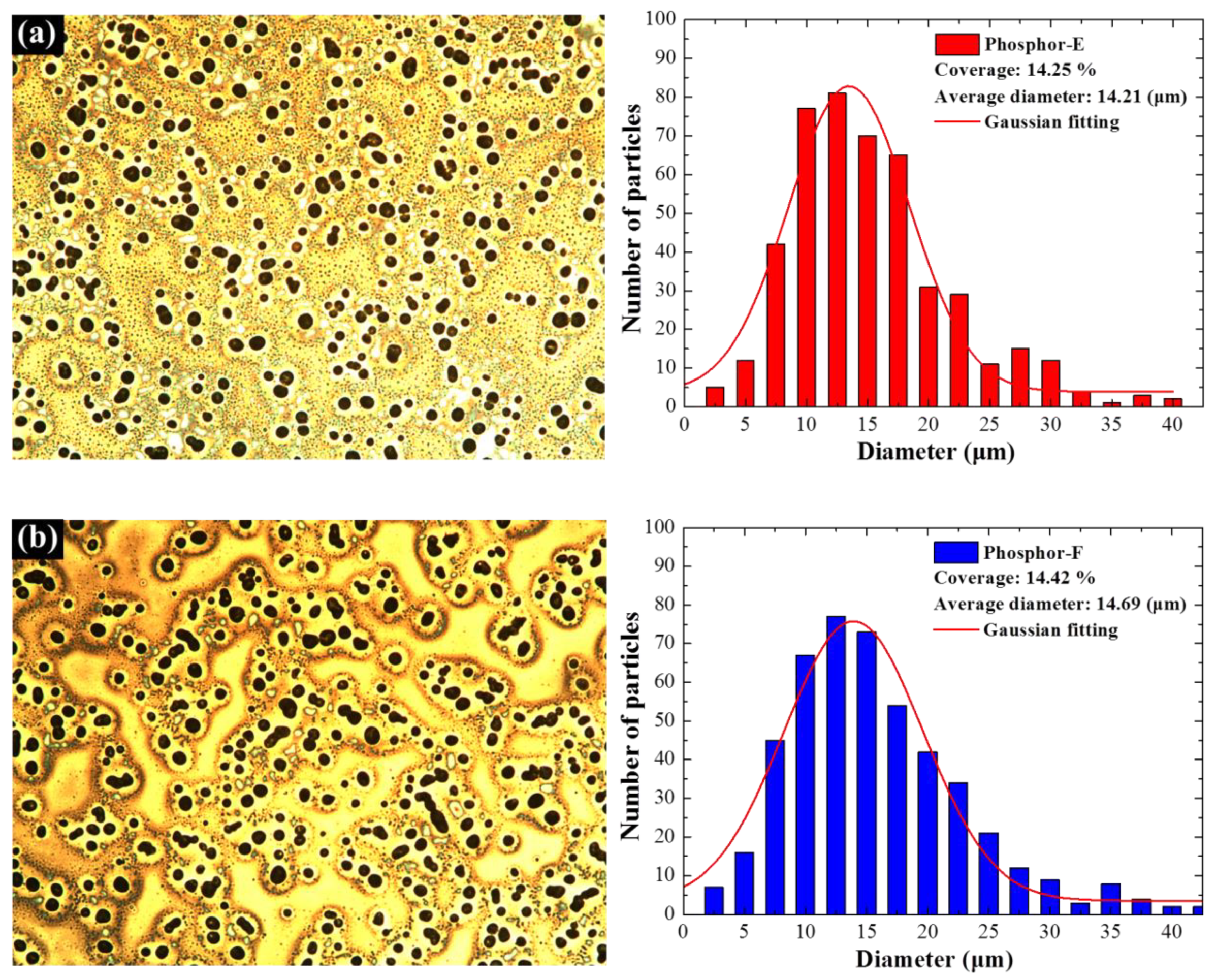
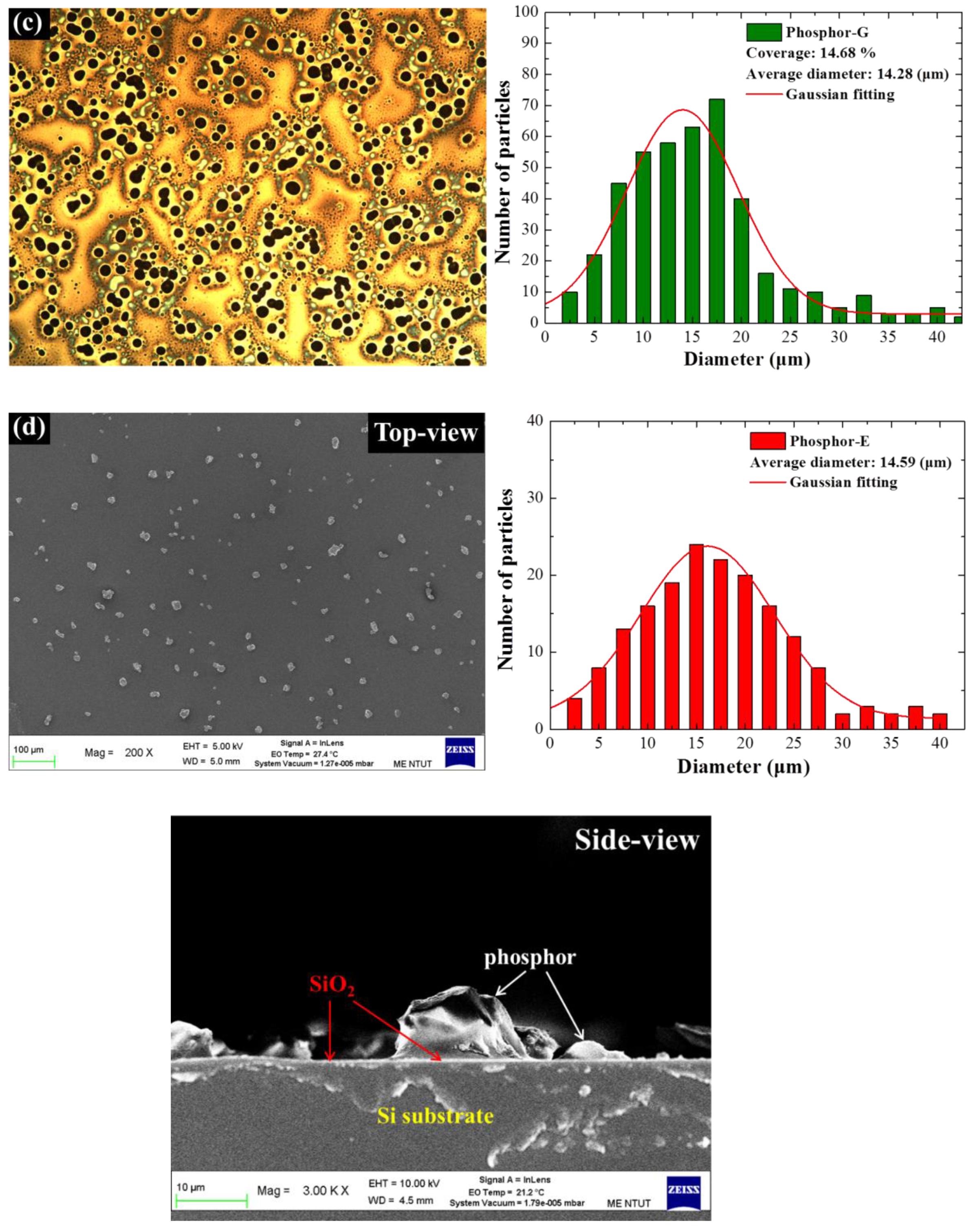
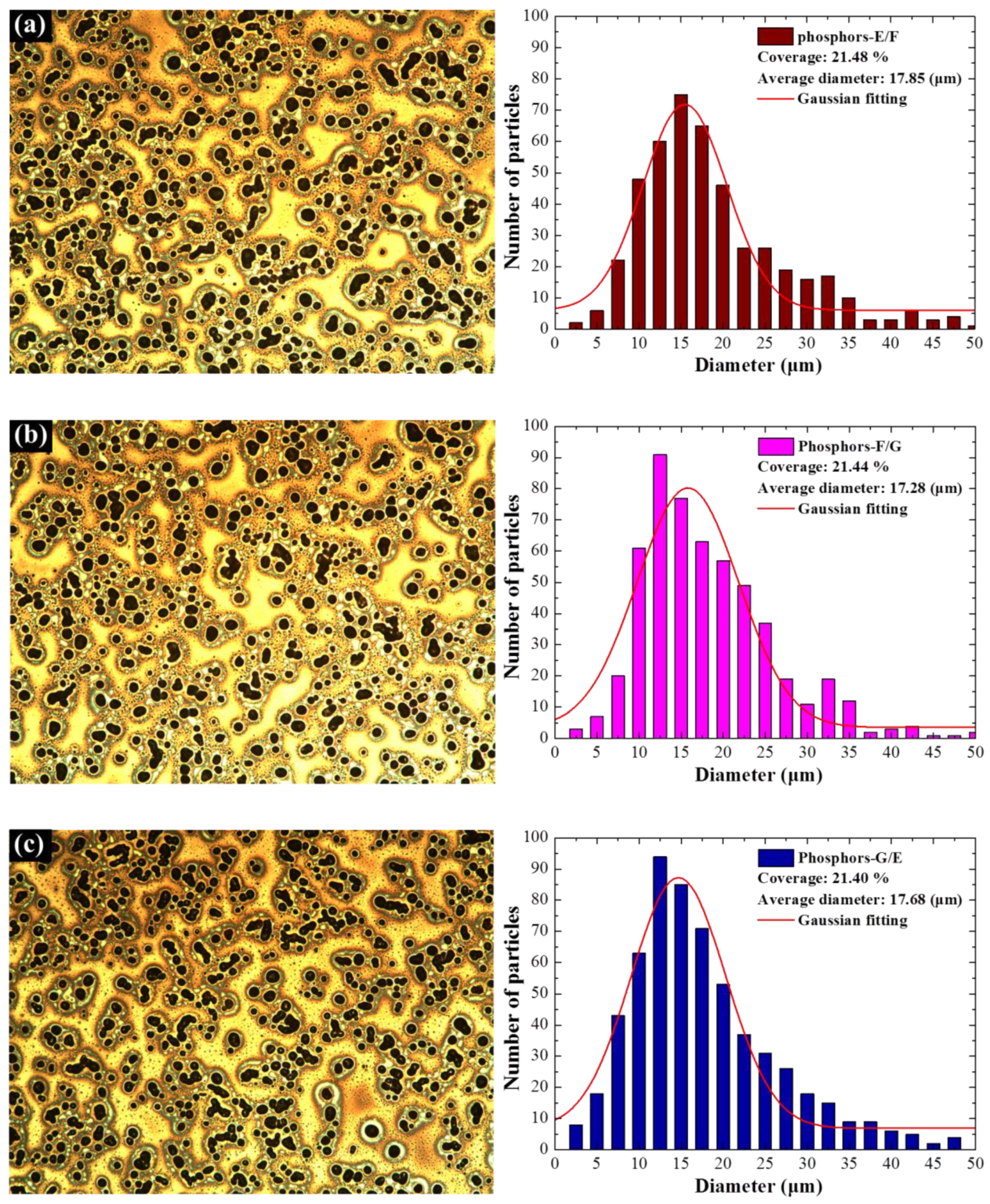
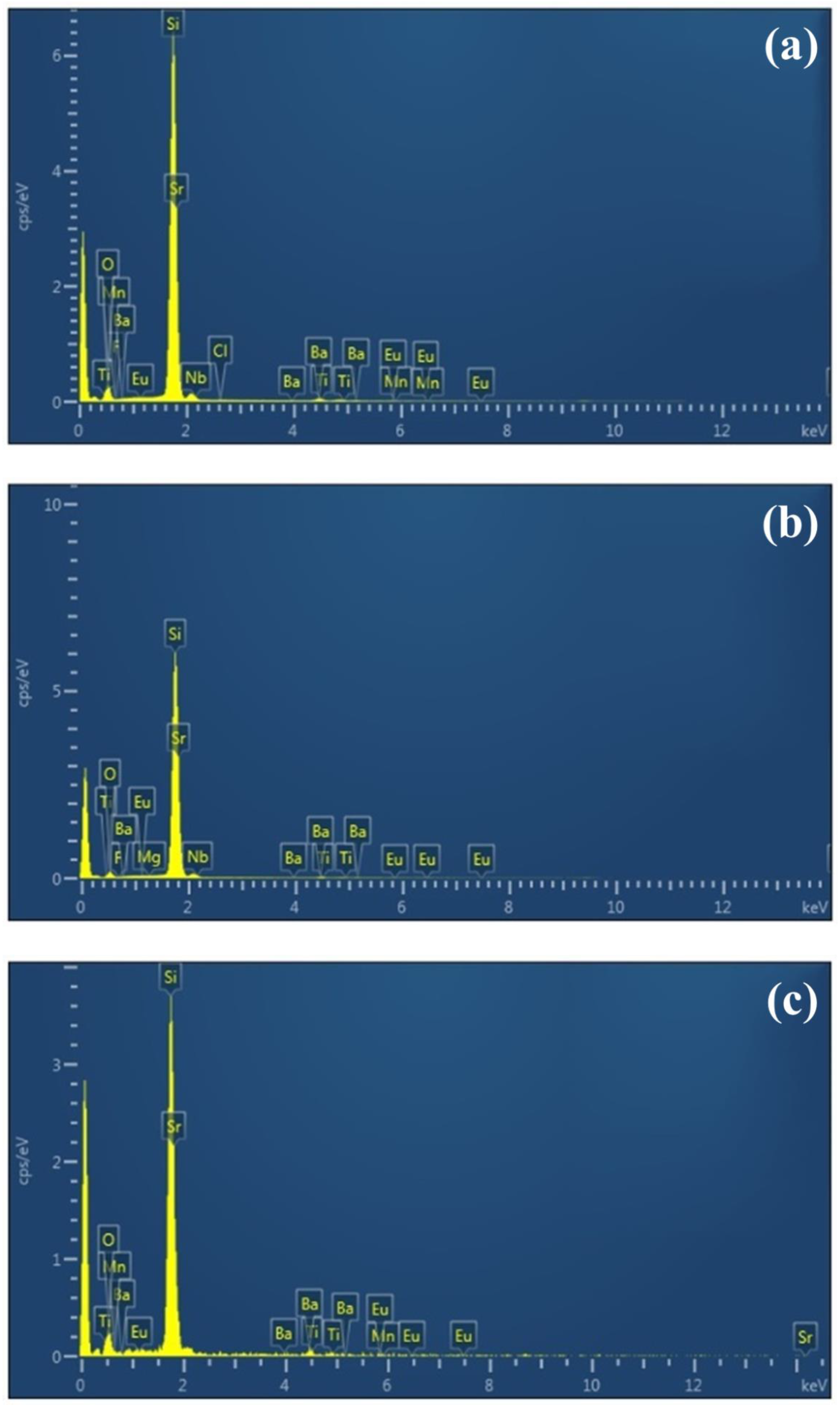
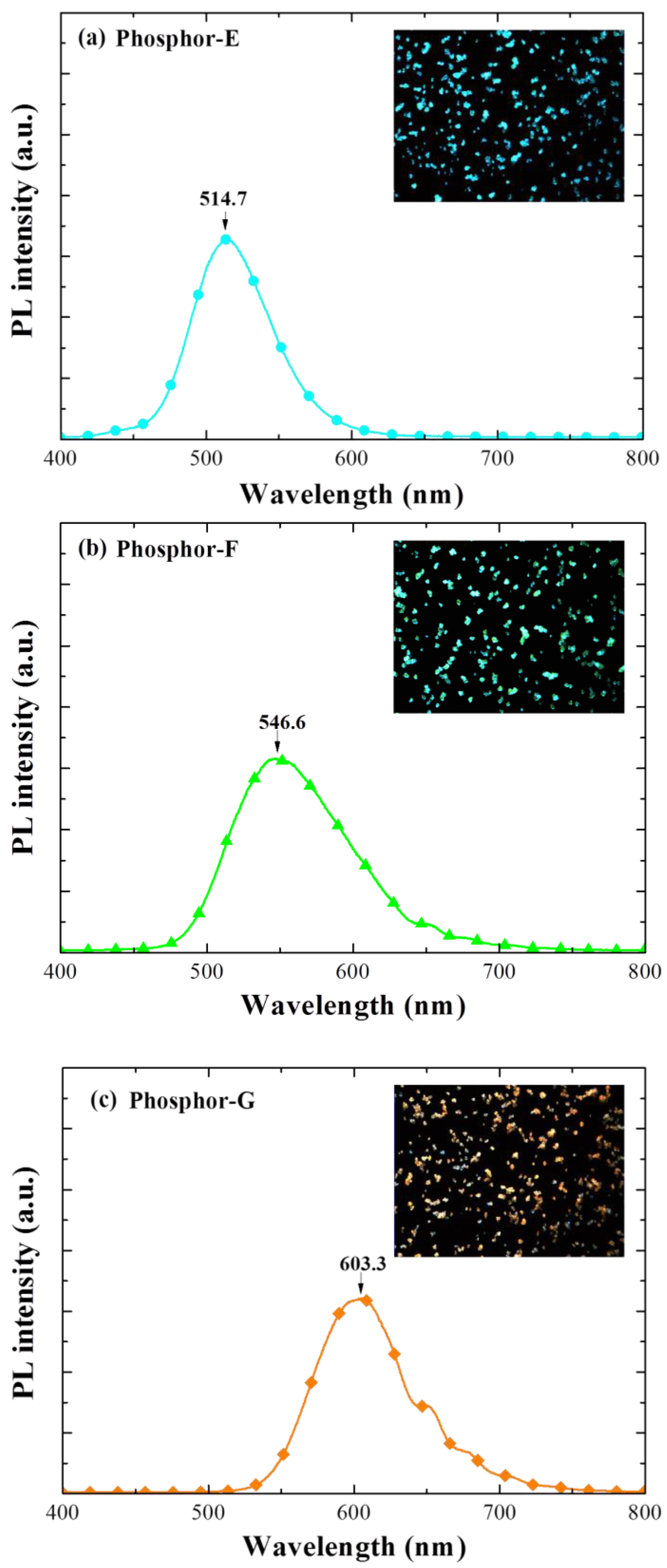
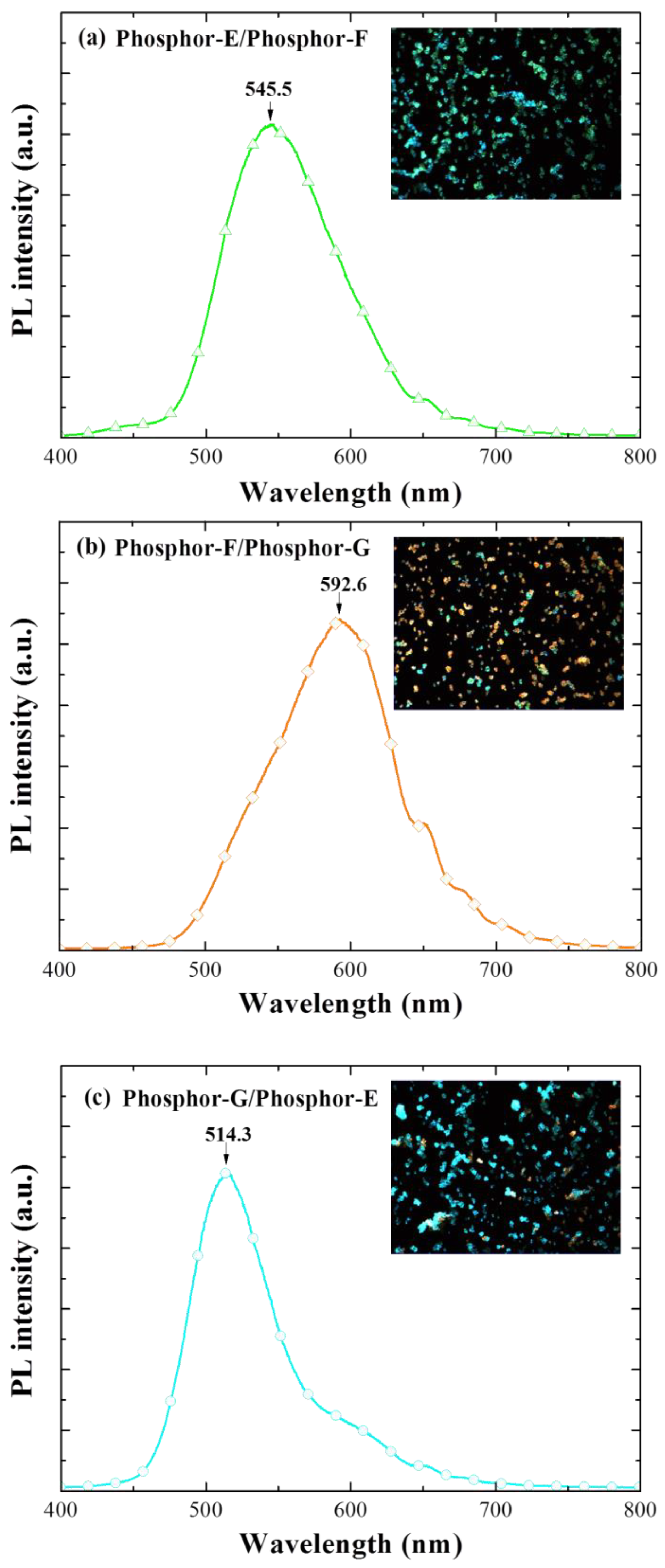
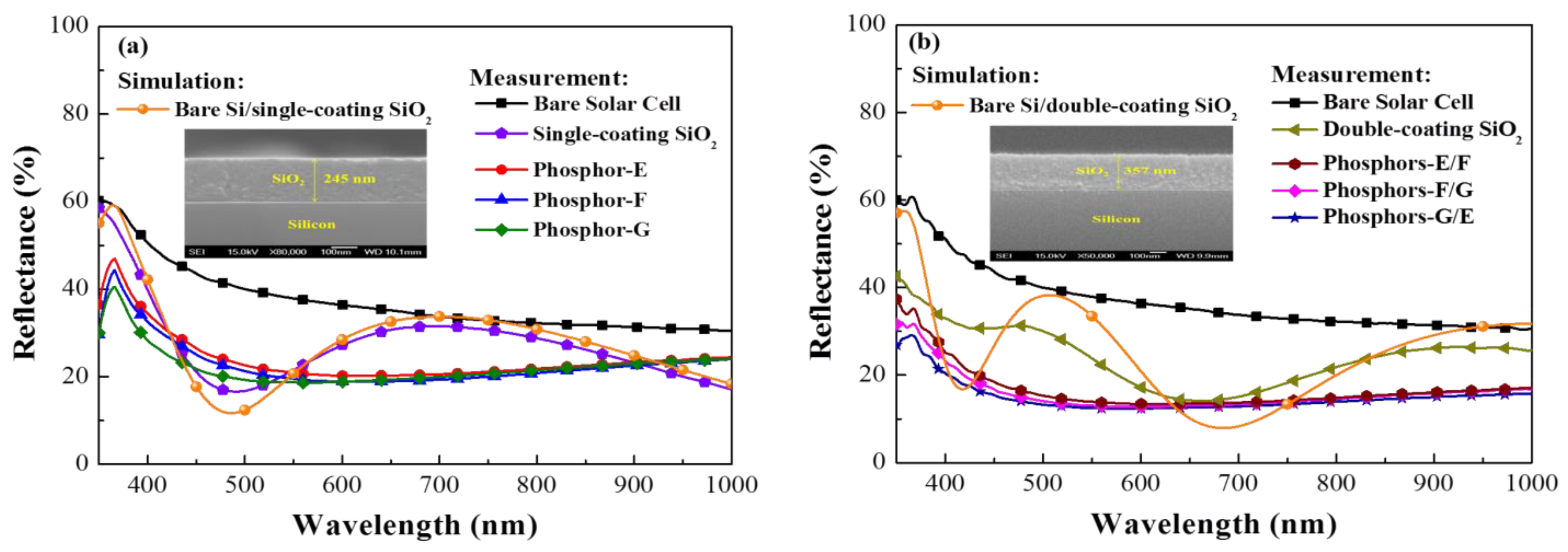
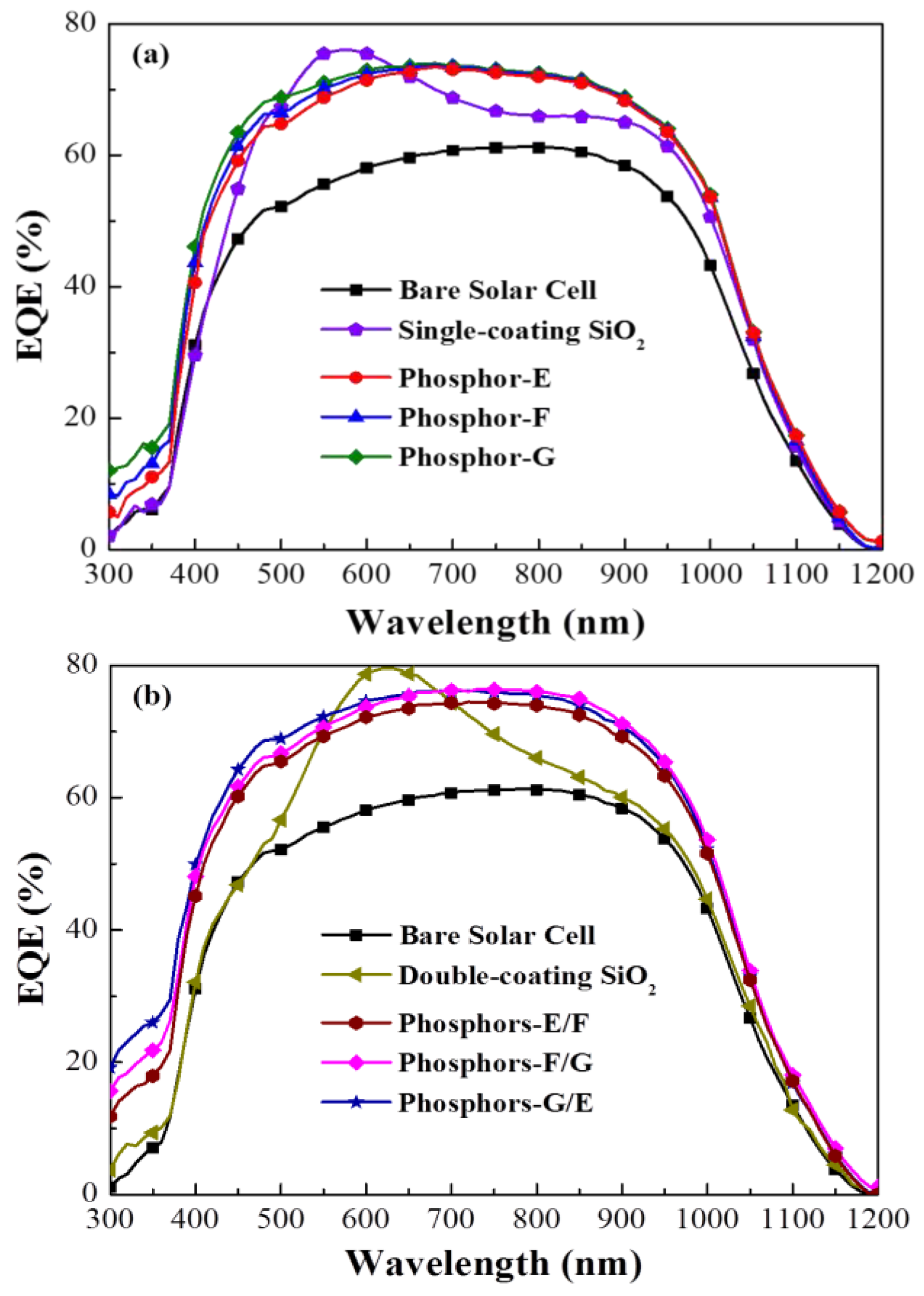
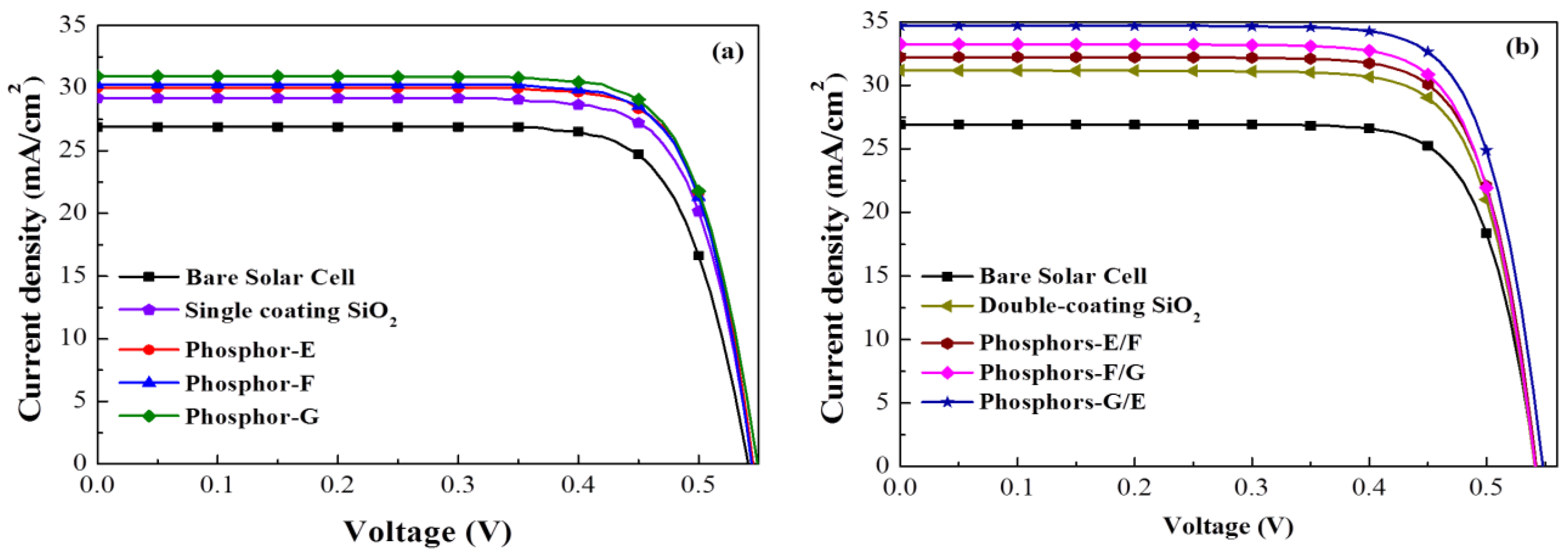
| Sample | RW (%) @ 350–450 nm | RW (%) @ 350–1000 nm | EQEW (%) @ 350–450 nm | EQEW (%) @ 350–1000 nm | Cal. Jsc (mA/cm2) |
|---|---|---|---|---|---|
| Bare solar cell | 49.84 | 37.35 | 32.20 | 52.93 | 22.29 |
| Single-coating SiO2 | 36.18 | 26.74 | 33.86 | 62.47 | 26.19 |
| SiO2: Phosphor-E | 33.48 | 23.43 | 41.68 | 64.30 | 27.04 |
| SiO2: Phosphor-F | 31.27 | 22.14 | 43.99 | 65.26 | 27.29 |
| SiO2: Phosphor-G | 27.78 | 21.45 | 46.40 | 66.21 | 27.66 |
| Double-coating SiO2 | 33.45 | 23.62 | 35.96 | 64.08 | 26.54 |
| Phosphor-E/Phosphor-F | 24.80 | 16.16 | 45.39 | 65.59 | 27.73 |
| Phosphor-F/Phosphor-G | 22.47 | 15.31 | 47.74 | 67.44 | 28.28 |
| Phosphor-G/Phosphor-E | 20.11 | 14.42 | 50.34 | 68.17 | 28.67 |
| Sample | Voc (mV) | Jsc (mA/cm2) | FF (%) | η (%) | ΔJsc (%) | Δη (%) | ΔηDS (%) |
|---|---|---|---|---|---|---|---|
| Bare solar (SC) | 541.3 | 26.91 | 76.45 | 11.14 | -- | -- | -- |
| Single-coating SiO2 | 544.8 | 29.20 | 77.22 | 12.28 | 8.51 | 10.31 | -- |
| SiO2: Phosphor-E | 546.8 | 30.04 | 78.07 | 12.82 | 11.63 | 15.16 | 4.40 |
| SiO2: Phosphor-F | 547.1 | 30.26 | 78.08 | 12.93 | 12.45 | 16.08 | 5.29 |
| SiO2: Phosphor-G | 548.1 | 30.97 | 77.01 | 13.07 | 15.09 | 17.39 | 6.43 |
| Double-coating SiO2 | 542.6 | 31.18 | 77.22 | 13.06 | 15.87 | 17.32 | -- |
| Phosphor-E/Phosphor-F | 543.4 | 32.24 | 77.57 | 13.59 | 19.81 | 22.03 | 4.06 |
| Phosphor-F/Phosphor-G | 544.4 | 33.25 | 77.28 | 13.99 | 23.56 | 25.62 | 7.12 |
| Phosphor-G/Phosphor-E | 547.4 | 34.69 | 77.19 | 14.66 | 28.91 | 31.63 | 12.25 |
Publisher’s Note: MDPI stays neutral with regard to jurisdictional claims in published maps and institutional affiliations. |
© 2022 by the authors. Licensee MDPI, Basel, Switzerland. This article is an open access article distributed under the terms and conditions of the Creative Commons Attribution (CC BY) license (https://creativecommons.org/licenses/by/4.0/).
Share and Cite
Ho, W.-J.; Liu, J.-J.; Ke, B.-X. Characterization of Luminescent Down-Shifting Spectral Conversion Effects on Silicon Solar Cells with Various Combinations of Eu-Doped Phosphors. Materials 2022, 15, 452. https://doi.org/10.3390/ma15020452
Ho W-J, Liu J-J, Ke B-X. Characterization of Luminescent Down-Shifting Spectral Conversion Effects on Silicon Solar Cells with Various Combinations of Eu-Doped Phosphors. Materials. 2022; 15(2):452. https://doi.org/10.3390/ma15020452
Chicago/Turabian StyleHo, Wen-Jeng, Jheng-Jie Liu, and Bo-Xun Ke. 2022. "Characterization of Luminescent Down-Shifting Spectral Conversion Effects on Silicon Solar Cells with Various Combinations of Eu-Doped Phosphors" Materials 15, no. 2: 452. https://doi.org/10.3390/ma15020452
APA StyleHo, W.-J., Liu, J.-J., & Ke, B.-X. (2022). Characterization of Luminescent Down-Shifting Spectral Conversion Effects on Silicon Solar Cells with Various Combinations of Eu-Doped Phosphors. Materials, 15(2), 452. https://doi.org/10.3390/ma15020452






